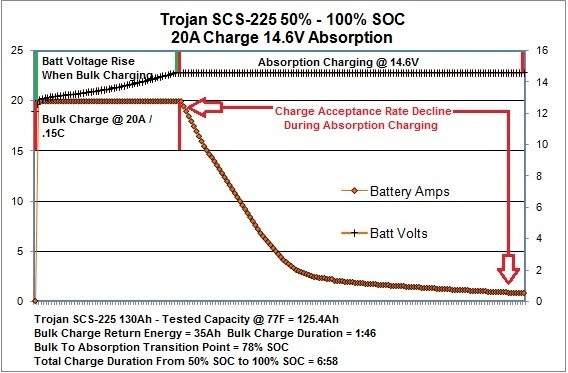Maine,
Have a question about my 2 x 4D battery bank connected in parallel. I recently posted about my new solar installation with a single panel on a pole that is aimable. My boat is at a dock most of the time with shore power. Is it better to leave my charger on to keep the batteries fully charged or doing what I have been doing which is to turn the charger off. I run my fridge all the time so at night the battery bank drops to about 91% of charge and then the panel has them back to 100% by about midday. Is it better for battery health and longevity to allow them to cycle like that or should I keep my battery charger turned on? FYI, it is a brand new Promariner 30 amp smart charger. Thanks
bob
Leave the charger on..
The idea that solar can recharge to 100% SOC by midday is rarely if ever happening and it is Ah counters that mislead folks...
Even if we assume you are only discharging to 90% SOC, and assuming we actually got to 100% SOC the day before, at face value that would mean we need to replace approx 25Ah. At an average of 5A that is 5 hours Now we have to subtract the fridge cycle-time and any other DC loads are on and we're now pushing beyond 3:00 PM at
face value and we've not even considered charge efficiency or poor charge algorithms.. Unfortunately batteries don't charge at "
face value" they charge with a
worsening charge efficiency the higher you go in SOC. Once at constant voltage (
absorption or
float) the battery decides how long charging takes not the array.
The last 10% of SOC for battery charge efficiency is
horribly inefficient. In the upper 90's it gets as bad as only .35Ah for every 1Ah delivered to the battery being converted to usable stored energy. Sandia National labs actually studied solar and charge efficiency and they never attained the rated capacity of the battery, which means it was not getting full within the time parameters and this was due to charge efficiency.
It is very difficult to get typical deep cycle lead acid batteries to 100% in a single solar day due to how long the current taper is. The best course of action is a mix of alternator or genset and charger to get through bulk and a ways into absorption then let the solar finish it. Depending upon the health of the batteries, or the type, and your on-board DC loads, you
may be able to get to 100% SOC in one solar day but on a boat it is less likely than it is likely..
Even a very healthy basically brand new Trojan flooded lead acid battery, charged at .15C or 15% of its Ah capacity, for your bank this would be a 43.5A charge rate, takes nearly 7 full hours to get to 100% SOC from 50%.
IMPORTANT: The absorption voltage of 14.6V (ideally it should be 14.8V but this test was to mimic a customers best case scenario at his chargers limit) was
held constant for the entire charge cycle all the way to 100% SOC. If you drop to a float voltage any time before you hit 100% SOC the charge time to 100% SOC will be
extended by many hours or even days.
As the batteries age and sulfate this time only extends. It is not uncommon to see flooded batteries that take 10+ hours to go from 50% SOC to 100% SOC. Starting at 91% does not really shorten the acceptance part of charging because the battery determines that.
On top of all that we have factory charge algorithms that enter float
prematurely, many at just 2 hours, and they often have too low an absorption or float voltage. All of these parameters, absorption time, absorption voltage and float voltage, unless heavily custom modified, and also greatly extend your time to 100% SOC. If you drop to a 13.2V float, after just 2 hours at 14.2V, your charge time to 100% SOC could be measured in
days not
hours..
My point is that you will often be PSOC cycling your battery with solar, where as with a charger it will always be at 100% SOC even with the fridge loads. While shallow cycling is better for batteries than deep cycling no cycling is better. On top of that 4D batteries are really not very good
cycling batteries, because they are not a
deep cycle battery, so the best course of action, for 4D or any batteries, is to not cycle them if you have the option not to.


